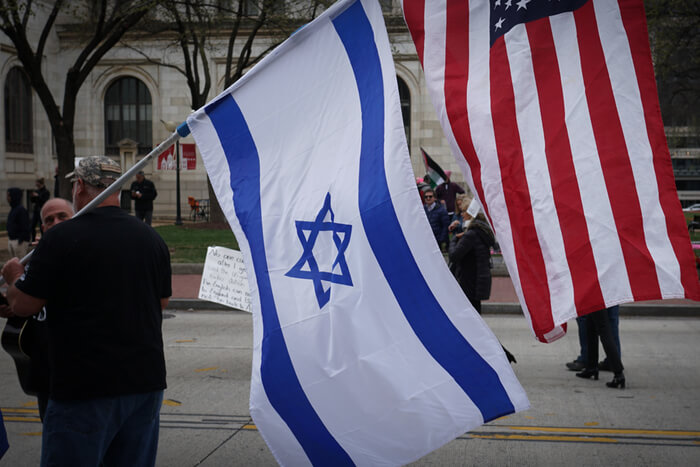
After-Action Report: The Wall Street Journal’s Skewed Front-Page Coverage of the Oct. 7 Massacre and Israel’s Response
The news coverage of events in Israel and Gaza since October 7 have been, on the whole, troubling. The most obvious and well-covered example was the rush to (falsely) blame Israel for a hospital bombing that turned out not to have come from Israel, and not to have hit the hospital at all. But there are countless subtler ways that coverage has been skewed to minimize worldwide sympathy for Israelis and increase sympathy for Hamas-sympathizers.
This article illustrates some of these little appreciated but powerful tactics through a close examination of the Wall Street Journal’s front page coverage of events in Israel/Gaza in the four weeks starting Oct. 7, with a particular emphasis on the first two weeks, when events in the Middle East dominated front-page coverage and reader impressions of the conflict were largely formed.
The Wall Street Journal is both the largest-circulation physical newspaper in America and, due to the bent of its editorial page, considered a conservative and pro-Israel publication. If the coverage in the Journal is skewed, that has an outsized impact on American opinion-makers given its readership. And the issues identified with the Journal’s coverage are generally applicable to a wide swath of other American newspapers and periodicals.
This analysis reviews the twenty-four The Wall Street Journal print edition cover pages from Monday, October 9–the paper’s first hard-copy coverage of the October 7 attacks–through Saturday/Sunday, November 4-5, with a particular emphasis on the first two weeks of coverage.
The analysis focuses on cover-page headlines and photographs, rather than the substantive content of the articles. It does so because headlines and photographs shape reader perception disproportionately (see for example https://www.newyorker.com/science/maria-konnikova/headlines-change-way-think).
The analysis illustrates the subtle ways The Wall Street Journal’s front page news coverage has been skewed over the month since October 7 to shift reader sympathies away from Israel—in ways that apply equally to many other publications’ coverage.
Executive Summary:
The Wall Street Journal coverage has primary if not entirely used language that presents the unprovoked October 7 Hamas terrorist attack—the third-largest terror attack in modern history by number of victims—in military terms, repeatedly calling the Hamas massacres an “attack” by “militants” or even “fighters,” or part of a “battle” with Israel, that create moral equivalency between the terrorist attacks and Israel’s response. The coverage across the period examined does not appropriately and clearly explain the chronology under which Hamas engaged in mass murder and mass terrorism, and in response Israel took military action.
Moreover, there has been little front page coverage of Israeli victims and the hostages currently being held in Gaza, and in particular their names and stories, and no front page coverage at all that describes in narrative form or any kind of detail the rampaging massacres, torture, gleeful killings in cold blood, burning alive, dismemberment, terror, rape, and elimination of entire families of civilians, from babies through grandparents, by 1,500+ armed terrorists on October 7. Instead, we get clinical descriptions like “the weekend attack that killed 1,300 Israelis” (as if it was a military operation by one army against another, and not a mass terrorist attack on civilians, resulting in a massacre the likes of which we have rarely if ever seen in modern times).
As for the pictures, looking at all twelve front pages covering the first two weeks following October 7, there are seven in which only Palestinians are shown under barrage, dead, or displaced; there are two in which both Palestinians and Israelis are shown as victims or recipients of violence; and there are two such photos of only Israelis (plus one showing religious Jews boarding a plane to leave the region). Moreover, there is not a single picture of an Israeli victim or hostage in any of them—by which I mean their faces (there are a few of Israeli bodybags), so the reader can empathize and humanize the loss—except the October 11 picture that has a poster-board of one of the victims as a portion of the picture, and that simply says the person is “missing.” In contrast, there are multiple front page pictures of Palestinians—usually elderly or holding babies (see October 14-15, October 16, and October 20, with October 16 having three separate pictures on one page, each with babies or children). Why no pictures of the Israeli babies killed on October 7? Or the babies currently being held hostage in Gaza? Or Israeli victims of any kind?
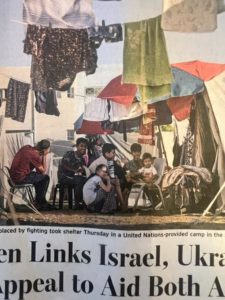
The next two weeks of front page photographs are even more skewed, with eight front pages in which only Palestinians are shown under barrage or displaced—again with multiple showing the elderly or children—and only one front page in which any Israeli victims are shown (showing two released hostages), while three show neither. The headlines during these weeks similarly almost exclusively focus on the impact of Israeli operations, and specifically the displacement of Palestinians. Headlines almost never reference the Israeli victims of the Oct. 7 attacks or the hostages, and never once reference the thousands of Israelis displaced by the Oct. 7 massacre.
Analysis of individual cover pages:
Week 1:
The lead front-page headline on Monday, October 9—WSJ’s first hard-copy coverage of the events—is “Israel and Hamas Battle, Death Toll Rises.” The copy under the headline similarly characterizes the October 7 events as “the Hamas militant group launched a surprise coordinated attack from Gaza that killed hundreds” and quickly notes that it “triggered deadly counterstrikes…” Nowhere in the copy on the front page of that article is there any mention—let alone description—of civilians hunted by 1,500+ terrorists, women raped, a music festival full of young people attacked, grandparents and babies being taken hostage to Gaza, U.S. citizens among them (I would have thought that would be a pretty big deal…) etc., that led to the “counterstrikes” (which itself suggest that they were in response to military action, not a savage terrorist attack) except one sterilized reference to an unknown number of Israeli’s being “held hostage.” And the top, largest picture is of fire and smoke in Gaza “following an Israeli airstrike in retaliation for the early Saturday multifront attack on Israel by Hamas militants” (per the photo description)—again suggesting military action by one side followed by “retaliation” (which itself has a negative, vengeful connotation) by the other.
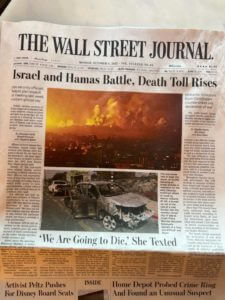
The headline for Tuesday, October 10 is even worse, focusing exclusively on the “Israeli Offensive against Hamas” (Israel once again as the aggressor) and again showing a lead picture of the aftermath of a rocket attack in Gaza. And again little if any focus on Hamas’s massacre and the victims and hostages.
Wednesday, October 11 is a bit better, since the paper covering the President’s remarks calling the attack on Israel “Sheer Evil.” But other than covering that statement, again not a word on the front page (across three articles) of the mass murder and rape of civilians, the attack on a music festival killing over 250 just in that one location, the livestreaming of the rampage, the killing of entire families, or any of the cruel and gruesome and inhumane details that had emerged and were easily accessible. We do get a photo of a “missing” Israeli-American since the Hamas “attacks,” but nothing on “captives” or “hostages” that babies and young children were being held, or the presumed number of American hostages. Everything is clinical, generalized, and in the language of war (for example, the front-page article “Militants Boosted Holdings of Crypto Over the Past Year” starts “Hamas’s lightning strike on Israel last weekend…” . And most of the focus is on the anticipated military response from Israel.
Thursday, October 12: The lead headline is again about Israel (and only Israel) waging war: “Israel Forms Unity Cabinet to Wage War,” with the subheading noting Israel’s “Gaza strikes intensify, offensive is awaited” and the copy focusing on “Israeli strikes in Gaza” and the “escalating humanitarian crisis.” What about the devastation (and humanitarian crisis) wrought by the 1,400 (at that point we thought 1,200) killed, thousands wounded, and thousands upon thousands forced to flee from Israel’s south at the hands of 1,500 or more terrorists, and now displaced? The picture is of wrapped bodies of Israeli victims, but the second article headline again called the October 7 massacres “assault by Hamas” (again a military word) and focuses on concerns about potential “wider war,” without noting the hundred-plus hostages, providing the reader with the narrative of October 7 (which, again, was well known by then), etc.
Friday, October 13: Top headline again only notes Israel’s aggression (“Israel Seeks to Wipe Out Hamas”) and the only picture is of Gaza after Israeli airstrikes. Again no mention anywhere on the front page of any of the stories or details of the October 7 attack or the hostages, except sterile, military-like references to “the weekend attack that killed 1,300 Israelis” (as noted, as if it was a military operation by one army against another, and not a mass terrorist attack on civilians, resulting in a massacre the likes of which we have rarely if ever seen in modern times). No mention of any victim’s name, no victim pictures, no victim or hostage stories.
Saturday/Sunday, October 14-15: The top headline again only about Israel’s anticipated aggression (“Gazans Brace for Israeli Offensive”), and as noted above the only pictures (three of them) are of Palestinians, all including children.
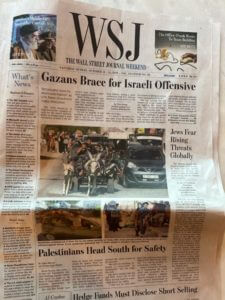
Week 2:
Monday, October 16: The only headline above the fold is “Gazans’ Conditions Worsen As Ground War Nears.” And while there are two pictures, and the Israeli one is on top, the Israeli one shows a coffin, while the Palestinian one is of an old lady holding a baby. Under the fold, there’s a story about the hostages, but it is again clinical. No mention of hostage names, ages, conditions, citizenship, etc.
Tuesday, October 17: The lead headline again in military terms, creating moral equivalency between the two sides (“War Shifts Global Dynamics,” with subheader referencing “Israel-Hamas conflict”). For the first time—ten days after Oct. 7—the lead article calls the attacks “brutal” (though it provides no details or description of why) and says those killed were “mostly civilians” (though it doesn’t provide the context that almost all of the Israelis killed who were in the military were killed in responding to the attacks in order to save civilians from a continuing and ongoing rampage). I don’t believe the paper anywhere on any of the front pages on any day tells the reader that the numbers of heavily armed individuals who invaded Israel and attacked civilians were north of 1,500 (just that number or more were killed by civilians and first responders). For the first time, there’s a front-page article that actually details the life and story of an American hostage. But this is 10 days in.
Wednesday, October 18: Here we have the now-discredited headline: “Blast at Gaza Hospital Kills Hundreds.” Whereas no headline at any point in time conveyed anything about the numbers of Israelis killed in the mass terror attack, this headline (it turns out incorrectly) says the hospital attack “kills hundreds.” And the article leads with “Hamas and Palestinian officials blamed Israel and said at least 500 were killed,” suggesting to the reader that the reporter thought this was likely the truth, followed by Israel’s statement that the evidence it had available indicated that it was “a misfire” by a Palestinian terrorist group. In other words, the paper accepted the unsubstantiated word of a terrorist organization over the evidence put forward by a democratic government. And the only picture on the front page is of what appears to be scores of dead Palestinians under sheets. Of course, this and similar stories around the world inflamed literal mobs, resulted in the cancellation of an Abbas-Biden meeting and other meetings that could have helped broker solutions for humanitarian concerns in Gaza, and turned out not to be anything close to true. The article lower down tells a detailed and moving story of one kibbutz in which the civilian defense force fended off 25-30 attackers. But again, this is not 11 days after the attack and the first time the reader is humanized to the civilians who were savagely attacked and largely massacred.
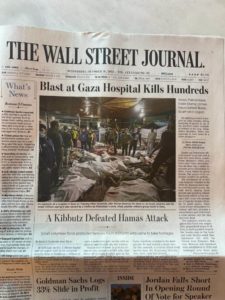
Thursday, October 19: The lower-down headline is a semi-retraction of the hospital blast story, but inexplicably shows a picture of a little girl (Palestinian) with the description that Hamas’s claim of an Israeli strike being “disputed”—rather than “debunked” or “shown to be false.” And the related headline says only that the U.S. and expert “say evidence suggests” it was a “Palestinian rocket.” Even though all of the available evidence supports that it was a Palestinian rocket, and there is no contrary evidence. So why not just come and say in your headline: “Evidence Shows Palestinian Rocket, Not Israeli Strike, Hit Gaza Hospital.”
Friday, October 20: The only photograph is again a large picture of Palestinian “displaced by fighting”—and specifically of Palestinian children. The only related headline above the fold—“Biden Links Israel, Ukraine In Appeal to Aid Both Allis” is arguably favorable to Israel, but like the headline of October 11, that is because it is conveying President Biden’s remarks. Below the fold, the headline is again neutral (“How the West Helped Fund Hamas”), but the sub-header calls Hamas “militants,” despite the text of the article noting that “the U.S. and its allies . . . deem [it] a terrorist organization.”
Saturday/Sunday, October 20-21: Once again, the only picture on the front page of events in the Middle East—this one on the top left of the front page—is of Gaza in smoke and flames. (For the first time during the period in question, the largest photograph on the front page is not of events in the Middle East.) No pictures of any of the hostages—despite an above-the-fold headline relating to Israel/Gaza being “Hamas Releases Two U.S. Hostages.” In that article, the Journal again refers to the October 7 massacre using clinical, military terms, referring to the hostages “taken by militants during an Oct. 7 raid that killed more than 1,400 Israelis.” The below-the-fold article similarly refers to Hamas terrorists in military terms: as “defenders” who “are energized by their successful surprise attack on Oct. 7, when Hamas fighters killed more than 1,400 people and grabbed more than 200 hostages.” Once again, no picture of Israeli victims. And once again, no names or descriptions of victims, or any description of the gruesome acts involved in “Hamas fighters” or “militants” killing more than 1,400 people and taking more than 200 hostages—the beheadings of babies, violent rape, dismemberment, tying whole families hands behind their backs before burning them alive, and cutting of a fetus out of a pregnant woman before stabbing the fetus and executing the mothers at point blank range. And again no mention that the 200 hostages include babies, children, and the elderly, civilians all; that holding civilian hostages is a violation of international humanitarian law; or that they are not receiving medical care despite grievous injury, or the opportunity to contact family members, again in violation of humanitarian law.
Week 3 (Monday, October 23 through Saturday/Sunday October 28-29):
The focus of the top headline on every day but one is Israel’s operations in Gaza and their impact (“Tensions Heighten As Israel Steps Up Airstrikes,” “Rush for Aid in Gaza Hits Hurdle as Fuel Runs Low,” “Israel Expands Gaza Operations”). Headlines or sub-headlines frame the Israeli operations in terms of their impact on “Humanitarian aid,” fuel running low, “fear” of “permanent displacement,” or “communications” being “cut off in the strip.” Israel’s operations are almost never presented in terms of their targeting of Hamas or the perpetrators of the Oct. 7 massacre, or on their impact on Hamas’s operations or infrastructure.
With respect to the photographs, three front pages contain primary, above-the-fold photographs of rubble or explosions in Gaza, with one of multiple Palestinian children holding food aid and one of the inside of a mosque. One front page a below-the-fold photograph of Israeli military vehicles entering Gaza, framed as “Israeli Armor Raids Gaza” (and an unrelated above-the-fold photograph). One front page has only unrelated photographs. And only one front page (October 24) has pictures of any Israelis—specifically, two released hostages (Oct. 24).
Reference to the October 7 attack is again to Hamas’s “Oct. 7 assault” (Oct. 23), and the perpetrators continue to be referred to as Hamas “fighters” (Oct. 26).
Week 4 (Monday, October 30 through Saturday/Sunday November 4-5):
The focus of the top headlines and photographs are again exclusively on Israel’s operations in Gaza and their impact on (sympathetic) Palestinian civilians, with four out of six front pages presenting an above-the-fold photograph of Palestinian civilians, including, once again, numerous front page photographs of elderly Gazan women and children (Oct. 31, Nov. 2, Nov. 3), and one picture of civilians searching through “the rubble from Israeli airstrikes” (Oct. 30). One is a neutral photograph of Anthony Blinken landing in Amman, Jordan after meeting with Benjamin Netanyahu (Nov. 4-5), though the headline under the photograph characterizes the meeting as follows: “Netanyahu Rebuffs U.S. Call For Pause in Strikes on Gaza.” In other words, Netanyahu refuses U.S. request for cease-fire. Only in the small text does the reader discover that what Netanyahu actually said was that “Israel refuses a temporary cease-fire that does not include the freeing of our hostages.” Finally, one front page has only an unrelated photograph, though the largest-print headline on the front page—above the fold—is nevertheless “Israeli Airstrike Hits Crowded Refugee Camp in North Gaza.” Once again, only in the article itself does the reader discover that the attack was actually on a “Hamas command and tunnel network,” that it had “killed large numbers of militants,” and that, per Israel’s military, the airstrike was directed within a refugee camp because “militants had taken control over civilian buildings in Jabalia refugee camp north of Gaza City.”
Over the entire week, not a single picture of a Jewish or Israeli victim or hostage is shown. And only one article discusses the Israeli victims—a Nov. 4-5 article on the toll identification of Hamas’ victims is having on forensic specialists in Israel. For the first and only time in the month of front page coverage since Oct. 7, the Wall Street Journal calls the events of Oct. 7 a “massacre.” But numerous other times over the course of the week, the events of October 7 are presented in military terms as the “Oct. 7 attacks on Israel” or the “surprise Oct. 7 attacks.”
Akiva Shapiro
If you found this content meaningful and want to help further our mission through our Keter, Makom, and Tikun branches, please consider becoming a Change Maker today.







